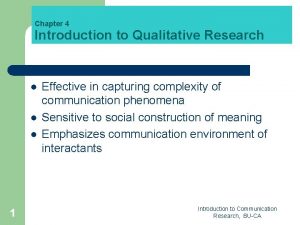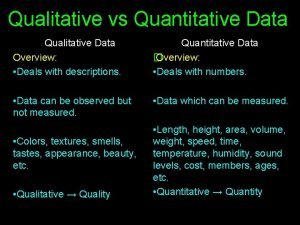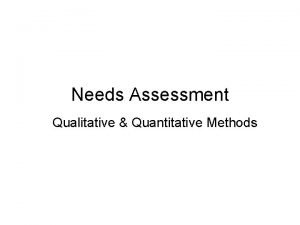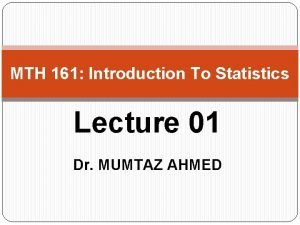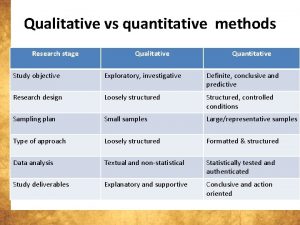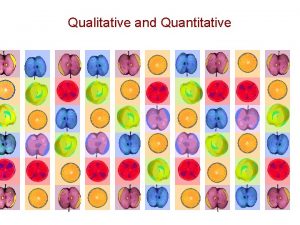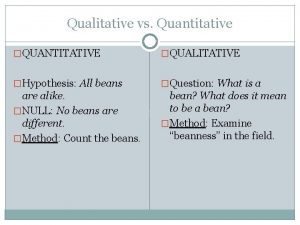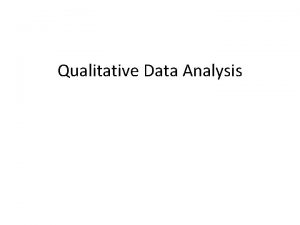Center of Statistical Analysis Qualitative and Quantitative Research





























- Slides: 29

Center of Statistical Analysis Qualitative and Quantitative Research CSA-D Presented By: EL Hajjar, Said Associate Professor, Ahlia University Second Semester, 2017 Dr. Said T. EL Hajjar 1

Qualitative Analysis Ø For many researchers, qualitative data analysis is a whirlwind of information that makes them feel lost. ( Often feel that they do not know where to start or where and when to end). Ø Multiple sources of qualitative data collected using different methods. (focus groups, observations, surveys, documents, … Ø Illustrate the steps and procedures that were followed in collecting the data. (to organize, understand, analyze, and interpret my qualitative data). Dr. Said T. EL Hajjar 2

Qualitative Analysis Ø Clarify how to progress from large piece of data (to codes, to find themes and meanings to inform our understanding of the world). Ø Qualitative research tends to try to uncover the reasons for behaviors, attitudes and motivations, instead of just the details of what, where and when. Ø Qualitative research can be done across many disciplines, such as social science, healthcare and business, and is a common feature of nearly every single workplace and educational environment. Dr. Said T. EL Hajjar 3

How to do Qualitative Research Ø Step 1: Decide on a question you want to study (Research Question(s)) * Clear, specific, and manageable. (Significance of Quality Assurance Agency at Higher Educational Institutions ) * Explore reasons for why people do things or believe in something. (Why HEI believes in QAA? ) *It determines what you want to learn or understand also helps to focus the study, since you can't investigate everything at once. (What values QAA has added to HEI? ) *Shape how you conduct your study since different questions require different methods of analysis. Dr. Said T. EL Hajjar 4

How to do Qualitative Research Ø Step 1: Decide on a question you want to study ( Research Question) *Find the balance between a burning question and a researchable question. *Start with a burning question and then narrow it down more to make it manageable enough to be researched effectively. (Ex. Burning question: “ what does the QAA stand for employees employed at universities in Bahrain ? . Then narrow it to: "what does the QAA stand for faculty at private universities in Bahrain? ) Dr. Said T. EL Hajjar 5

How to do Qualitative Research Ø Step 2: Do a literature review. *About your research question and particular topic. -Read widely on the larger field and examine studies that relate to your topic. - Then draw up an analytical report that synthesizes and integrates the existing research. In other words, you are "researching the research”. - A literature review will also help you to determine whether you are really interested and committed to the topic and research question and that there is a gap in the existing research that you want to fill by conducting your own investigation. Dr. Said T. EL Hajjar 6

How to do Qualitative Research Ø Step 2: Do a literature review. Example: if the research question focuses on how QAA measures the Higher Educational Institutions, then: -Examine the literature on the indicators used for assessment. - What motivates universities to turn to satisfy these indicators? - How many universities deal with QAA? - Where do most QAA work? (Private or Public). (Doing this will help you refine your question and give you the base you need for your own research. It will also give you a sense of the variables that might impact your research (e. g. , Private or public universities, international or local, staff or faculty, students, admin etc. ) and that you will need to take into consideration in your own study. Dr. Said T. EL Hajjar 7

How to do Qualitative Research Ø Step 3: Evaluate whether qualitative research is the right fit for your research question. * Qualitative methods are useful when a question cannot be answered by a simple “ Yes” or “No” Hypothesis. * Often qualitative research is especially useful for answering "how" “ when” or "what" questions. Dr. Said T. EL Hajjar 8

How to do Qualitative Research Ø Step 3: Evaluate whether qualitative research is the right fit for your research question. * Ex. If your research question is “ What values QAA has added to Higher Educational Institutions ? ", that is not a question that can be answered with a 'yes' or 'no'. This means that qualitative research is the best route. Dr. Said T. EL Hajjar 9

How to do Qualitative Research Ø Step 4: Consider your ideal sampling size. * Qualitative research methods don't rely as heavily on large sample sizes as quantitative methods, but they can still yield important insights and findings. *Your research budget and available financial resources should also be considered. Ex. Since it's unlikely that you have the funding to be able to study the significance of using QAA everywhere in the GCC, perhaps you choose to narrow your study to a major urban area (like Bahrain). Dr. Said T. EL Hajjar 10

How to do Qualitative Research Ø Step 4: Consider your ideal sampling size. * Consider the possible outcomes. Because qualitative methodologies are generally quite broad, there is almost always the possibility that some useful data will became visible of the research. Dr. Said T. EL Hajjar 11

How to do Qualitative Research Ø Step 5: Choose a qualitative research methodology *There a number of accepted methodologies: * Action Research – Action research focuses on solving an immediate problem or working with others on a problem to solve and address particular issues. * Ethnography – Ethnography is the study of human interaction and communities through direct participation and observation within the community you wish to study. Ethnographic research comes from the discipline of social and cultural anthropology. Dr. Said T. EL Hajjar 12

How to do Qualitative Research Ø Step 5: Choose a qualitative research methodology * Grounded Theory – The purpose of grounded theory is to develop theory based on the data systematically collected analyzed. It looks at specific information and derives theories and reasons for the phenomena. * Case Study Research – This method of qualitative study is an in-depth study of a specific individual or phenomena in its existing context. (Ex. Case study research usually relies on interviews and documentary materials, whereas ethnography research requires considerable fieldwork). Dr. Said T. EL Hajjar 13

How to do Qualitative Research Ø Step 6: Data Collection - One or more techniques to collect empirical data. ( interviews, participant observation, fieldwork, archival research, documentary materials, etc. ) - The form of data collection will depend on the research methodology. Dr. Said T. EL Hajjar 14

How to do Qualitative Research Ø Step 6: Data Collection *Direct observation – Direct observation of a situation or your research subjects can occur through video tape playback or through live observation. In direct observation, you are making specific observations of a situation without influencing or participating in any way. ( Ex. Perhaps you want to see how QAA panel go about their routines in and outside the classroom and so you decide to observe them for a few days, being sure to get the requisite permission from the university, and the panel and taking careful notes along the way). *Participant observation – Participant observation is the immersion of the researcher in the community or situation being studied. This form of data collection tends to be more time consuming, as you need to participate fully in the community in order to know whether your observations are valid. Dr. Said T. EL Hajjar 15

How to do Qualitative Research Ø Step 6: Data Collection *Interviews – Qualitative interviewing is basically the process of gathering data by asking people questions. -Interviewing can be very flexible (they can be one-on-one, but can also take place over the phone or Internet or in small groups called "focus groups". -There also different types of interviews. (Structured interviews use pre-set questions, whereas unstructured interviews are more free-flowing conversations where the interviewer can investigate and explore topics as they come up). -Interviews are particularly useful if you want to know how people feel or react to something. (Ex. It would be very useful to sit down with Faculty in either a structured or unstructured interview to gain information about how they represent and discuss the QAA effectiveness and its performance). 16 Dr. Said T. EL Hajjar

How to do Qualitative Research Ø Step 6: Data Collection *Surveys – Written questionnaires and open ended surveys about ideas, perceptions, and thoughts is another way in which you can collect data for your qualitative research. (Ex. In your study of QAA significance from the point of view of faculty, perhaps you decide to do a nameless survey of 100 faculty in the university because you're concerned that they may be less straightforward in an interview situation than in a survey where their identity was nameless). Dr. Said T. EL Hajjar 17

How to do Qualitative Research Ø Step 6: Data Collection *Document analysis – This involves examining written, visual, and audio documents that exist without any involvement or initiation by the researcher. # There are lots of different kinds of documents. - Official documents produced by institutions and personal documents. (Ex. letters, memoirs, diaries). -Social media accounts and online blogs. (Ex. If studying a higher education case, institutions like private universities produce many different kinds of documents, including reports, flyers, handbooks, websites, curricula, etc. Maybe you can also see if any faculty have an online meet group or blog. -Document analysis can often be useful to use in conjunction with another method, like interviewing. Dr. Said T. EL Hajjar 18

How to do Qualitative Research Ø Step 7: Data Analysis Once you have collected your data, you can begin to analyze it and come up with answers and theories to your research question. There are number of ways to analyze your data. *Coding-Coding helps you organize your data and identify patterns and commonalities. -In coding, you assign a word, phrase, or number to each category. Start out with a pre-set list of codes that you derived from your prior knowledge of the subject. (Ex. “ documentations issues“ or "community involvement" might be two codes you think of after having done your literature review of faculty acceptance of QAA). -Then go through all of your data in a systematic way and "code" ideas, concepts and themes as they fit categories. Dr. Said T. EL Hajjar 19

How to do Qualitative Research Ø Step 7: Data Analysis * Descriptive Statistics – You can analyze your data using statistics. Descriptive statistics help describe, show or summarize the data to highlight patterns. (Ex. If you had 100 principal evaluations of QAA from faculty, you might be interested in the overall performance of those faculty. Descriptive statistics allow you to do that. Keep in mind, however, that descriptive statistics cannot be used to make conclusions and confirm/ disprove hypotheses). *Narrative analysis – Narrative analysis focuses on speech and content. (Ex. Grammar, word usage, symbols, story themes, meanings of situations, the social, cultural and political context of the narrative). Dr. Said T. EL Hajjar 20

How to do Qualitative Research Ø Finally: Write up your research When preparing the report on your qualitative research, keep in mind the audience for whom you are writing and also the formatting guidelines of the research journal you wish to submit your research to. You will want to make sure that your purpose for your research question is persuasive and that you explain your research methodology and analysis in details. Dr. Said T. EL Hajjar 21

How to do Quantitative Research Ø Quantitative Research - Quantitative methods emphasize objective measurements and the statistical, mathematical, or numerical analysis of data collected through polls, questionnaires, and surveys, or by manipulating pre-existing statistical data using computational techniques. - Quantitative research focuses on gathering numerical data and generalizing it across groups of people or to explain a particular phenomenon. Dr. Said T. EL Hajjar 22

How to do Quantitative Research Ø Characteristics of Quantitative Research - The goal in conducting quantitative research study is to determine the relationship between one thing [an independent variable] and another [a dependent or outcome variable] within a population. - Quantitative research designs are either descriptive [subjects usually measured once] or experimental [subjects measured before and after a treatment]. - The main aim of a quantitative research study is to classify features, count them, and construct statistical models in an attempt to explain what is observed. Dr. Said T. EL Hajjar 23

How to do Quantitative Research Ø Important Remarks -Before designing a quantitative research study, you must decide whether it will be descriptive or experimental because this will dictate how you gather, analyze, and interpret the results. - A descriptive study is governed by the following rules: subjects are generally measured once; the intention is to only establishing for association between variables; and, the study may include a sample population of hundreds or thousands of subjects to ensure that a valid estimate of a generalized relationship between variables has been obtained. -An experimental design includes subjects measured before and after a particular treatment, the sample population may be very small and purposefully chosen, and it is intended to establish causality between variables. Dr. Said T. EL Hajjar 24

How to do Quantitative Research Ø Main characteristics of QR • The data is usually gathered using structured research instruments. • The results are based on larger sample sizes that are representative of the population. • The research study can usually be replicated or repeated, given its high reliability. • Researcher has a clearly defined research question to which objective answers are required. • All aspects of the study are carefully designed before data is collected. • Data are in the form of numbers and statistics, often arranged in tables, charts, figures, or other non-textual forms. • Project can be used to generalize concepts more widely, predict future results, or investigate causal relationships. • Researcher uses tools, such as questionnaires or computer software, to collect numerical data. Dr. Said T. EL Hajjar 25

How to do Quantitative Research Ø Reporting the results of a study using quantitative methods - Explain the data collected and their statistical treatment as well as all relevant results in relation to the research problem you are investigating. Interpretation of results is not appropriate in this section. - Report unexpected events that occurred during your data collection. Explain how the actual analysis differs from the planned analysis. Explain your handling of missing data and why any missing data does not undermine the validity of your analysis. - Choose a minimally sufficient statistical procedure; provide a rationale for its use and a reference for it. Specify any computer programs used. - Describe the assumptions for each procedure and the steps you took to ensure that they were not violated. Dr. Said T. EL Hajjar 26

How to do Quantitative Research Ø Highly recommended tests used in a quantitative research - Normality Test (Skewness and Kurtosis ) - Descriptive Analysis ( Presentation of Data: Frequencies, percentage, Graphs Descriptive Statistics: Mean, median, mode, standard deviation) - Pilot Study: Reliability and Construct Validity. (Cronbach’s alpha, Item to item, item to total, Cronbach’s alpha if item deleted ) - Correlation ( Determine the linear correlation coefficient r and test its significance) - Regression Analysis ( Determine the coefficient of variation R-square and test its significance. Develop the equation of the regression line and test the significance of its slope) Dr. Said T. EL Hajjar 27

How to do Qualitative Research ↑ http: //www. qsrinternational. com/what-is-qualitative-research. aspx ↑ http: //isites. harvard. edu/icb/icb. do? keyword=qualitative&pageid=icb. page 340887 ↑ https: //explorable. com/what-is-a-literature-review ↑ http: //isites. harvard. edu/icb. do? keyword=qualitative&pageid=icb. page 350640 ↑ https: //explorable. com/qualitative-research-design ↑ http: //www. qual. auckland. ac. nz/ ↑ http: //www. socialresearchmethods. net/kb/qualapp. php ↑ http: //www. qual. auckland. ac. nz/ ↑ http: //www. socialresearchmethods. net/kb/qualdata. php ↑ http: //www. socialresearchmethods. net/kb/qualapp. php ↑ http: //isites. harvard. edu/icb. do? keyword=qualitative&pageid=icb. page 340338 ↑ http: //isites. harvard. edu/icb. do? keyword=qualitative&pageid=icb. page 340889 ↑ http: //www. qual. auckland. ac. nz/ ↑ tobaccoeval. ucdavis. edu/analysis-reporting/. . . /Coding. Qualitative. Data. pdf ↑ https: //statistics. laerd. com/statistical-guides/descriptive-inferential-statistics. php ↑ http: //www. qual. auckland. ac. nz/ ↑ https: //explorable. com/qualitative-research-design Dr. Said T. EL Hajjar 28

End “ Statistical methods could be used to support a theory, but they rarely have been used to prove a theory. ” THANK YOU 07/03/2017 Dr. Said T. EL Hajjar 29
 Qualitative vs quantitative data analysis
Qualitative vs quantitative data analysis Findings of qualitative research
Findings of qualitative research Similarities between qualitative and quantitative research
Similarities between qualitative and quantitative research Similarities between qualitative and quantitative research
Similarities between qualitative and quantitative research Sampling methods in qualitative and quantitative research
Sampling methods in qualitative and quantitative research Purpose of qualitative research
Purpose of qualitative research Data analysis in research
Data analysis in research Qualitative vs quantitative data analysis
Qualitative vs quantitative data analysis Qualitative and quantitative data analysis
Qualitative and quantitative data analysis Qualitative vs quantitative research
Qualitative vs quantitative research What is qualitative data
What is qualitative data Qualitative and quantitative data difference
Qualitative and quantitative data difference Example of quantitative observation
Example of quantitative observation Different between qualitative and quantitative
Different between qualitative and quantitative Ordinal variable example
Ordinal variable example Quantitative and qualitative variables examples
Quantitative and qualitative variables examples Bicholestadien
Bicholestadien Quantative observation
Quantative observation Qualitative physical properties
Qualitative physical properties Qualitative and quantitative difference
Qualitative and quantitative difference Qualitative and quantitative difference
Qualitative and quantitative difference Inheritance of quantitative traits
Inheritance of quantitative traits Disadvantage of qualitative research
Disadvantage of qualitative research Qualitative and quantitative
Qualitative and quantitative Quantitative and qualitative in chemistry
Quantitative and qualitative in chemistry Integrating qualitative and quantitative methods
Integrating qualitative and quantitative methods Inheritance of quantitative traits
Inheritance of quantitative traits Research paper appendices example
Research paper appendices example Chapter three research
Chapter three research Nature of qualitative research
Nature of qualitative research



